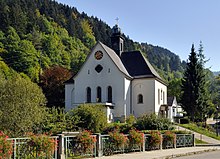Assumption of Mary (Atzenbach)
Assumption of Mary is a Roman Catholic church in the Atzenbach district of Zell , which was built in the late 1920s in the neo-Renaissance style.
history
The Church of the Assumption of Mary in Atzenbach was built between 1928 and 1929. The planning goes back to the senior building officer H. Graf and the senior building inspector Luger from the archbishop's building authority in Freiburg. In 1942 the parish of Atzenbach was separated from Zell im Wiesental as a curate and in 1964 it became an independent parish . In 1972 the interior and the area of the main entrance were newly created. Another interior renovation took place in 2002. The new altar and ambo made of Jura marble were created by the artist Siegfried Fricker.
description
Church building
The Church of the Assumption is located on the thoroughfare of Atzenbach, on the left, not far from the meadow . To the with a gable roof covered nave north and south short choral close transepts, east apse , whose roofs hipped are. The main portal in the west facade is protected by a small anteroom with a flat roof. There are three arched windows above it. In the gable there is a small rose window , and above it is the dial of the church clock. The south transept has a side entrance with a small porch. Above the side entrance, a statue is embedded in the wall as a relief, which is flanked by two arched windows. A small, square roof turret with angular sound arcades rises above the crossing and is crowned by an onion dome , a tower ball and a cross.
Interior and equipment
In the interior there is a flat domed vault at the crossing, the chancel and the aisles have a flat ceiling. In the choir there is a simple ambo and altar made of marble. A red rectangle is painted on the back wall of the choir. On both sides of the choir, two oil paintings decorate the side altars. The left picture shows the Holy Family, on the right the blessing Jesus Christ. The representations come from the Freiburg painter Hans Franke.
organ
The organ in the gallery above the main entrance from 1953 comes from the GF Steinmeyer & Co. workshop in Oettingen. The instrument works with an electric game and stop action and comprises two manuals , a pedal and 26 stops .
|
|
|
||||||||||||||||||||||||||||||||||||||||||||||||||||||||||||||||||||
- Coupling : II / I, I / P, II / P
Bells
The three-part bell is composed as follows:
| No. | Chime | Casting year | material | foundry |
|---|---|---|---|---|
| 1. | d ′ | 1950 | Chilled iron | JF Weule , Bockenem |
| 2. | it' | 1950 | Chilled iron | JF Weule, Bockenem |
| 3. | as ′ | 1928 | bronze | Grüninger bell foundry |
literature
- Johannes Helm : Churches and chapels in the Markgräflerland. Müllheim / Baden 1989, ISBN 3-921709-16-4 , p. 451.
Individual evidence
- ↑ H. Vocke (ed.): The chronicle of the district of Lörrach. 1966, p. 65.
- ↑ Siegfried Fricker: create from ours . Issue 8, 1973, p. 34.
- ↑ 850 Years Atzenbach , 1963, pp. 30–32.
- ^ Helm: Churches and chapels in the Markgräflerland. P. 451 (08.2)
- ↑ Information on the organ
Web links
Coordinates: 47 ° 42 ′ 46.4 " N , 7 ° 52 ′ 20.5" E



